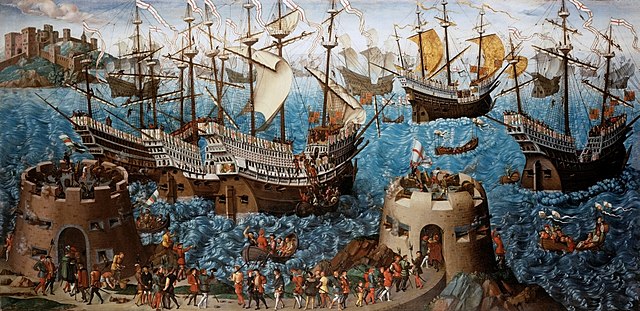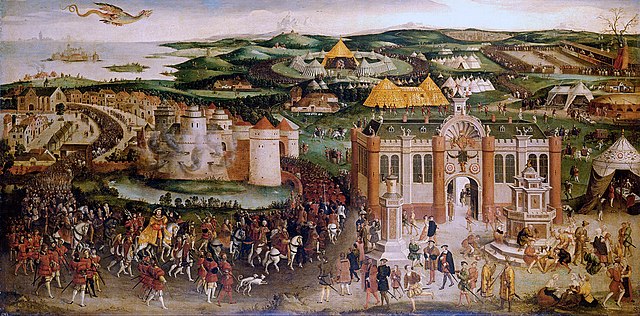After what must have been hectic preparations that spring this famous meeting took place between June 7 and 24 1520. If its aim was to confirm what diplomacy had achieved its practical side was an extraordinary and extravagant meeting of the two Courts. The Wikipedia account lists those attending, and it was a
huge number drawn from the governing elites of both realms. Perusing it I was interested to see the name of Bishop Fisher, about whom I posted the other day, amongst those attending. The useful illustrated account can be viewed at Field of the Cloth of Gold
This was not the first such Anglo-French summit meeting in the Pas de Calais. About a century and a quarter earlier the nearby villages of Leulinghem and Nort-Leulinghem had hosted the discussions that led to the Truce of Leulinghem in1389 and then in 1396 the meeting of King Richard II and King Charles VI and their retinues together with the handing over of the French king’s daughter Isabella to be the English king’s child bride. This is covered in considerable detail in Nigel Saul’s Richard II and had similar elements of lavish display and generous gift exchange. In 1475 at Picquigny King Edward IV and King Louis XI met to negotiate the Yorkist King being bought off by the Valois monarch following his invasion. On this occasion security was at a premium, with the two kings embracing through a wooden grille - after what had happened at Montereau in 1419 people were not taking chances.
The 1520 meeting was set in the context of a jousting tournament. Such occasions were also not unknown in the area: in 1390 the international jousts of St Inglevert were convened by Marshal Boucicaut and his two friends, as referred to in my recent post Tournament Time
However the Field of Cloth of Gold was, so far as we can tell, the grandest and most opulent Grandest and last of its type. When King Henry VIII and King Francis I met on a second, and last occasion in 1532 at Calais the meeting was on a much smaller scale.

Image: Wikipedia from Royal Collection Hampton Court
To mark the quincentenary the very useful website The Tudor Travel Guide -
https://thetudortravelguide.com - created by Dr Sarah Morris organised an online conference about the events of 1520. Given that one has been in ‘lockdown’ I have virtually attended recently several historical conferences. This particular series of talks and interviews are available through the Tudor Travel Guide website as YouTube videos. They are all excellent, different one from another and all well worth watching. Informative and engaging, they are worth subscribing to if you are at all interested in the period.
One thing that was brought out was the sheer scale of the operation to organise and provide for the Field. The logistics are a tribute to the Henrician Office of Works and its staff, the officers of the King’s Court and the general ability to get things done in an age without so much of what we would think essential.
Another aspect was the concern about the precise management of contact between the two monarchs so that neither could feel slighted by the other but that absolute parity was achieved and maintained at all times.
The accuracy of the painting of the arrival of King Henry VIII, though painted about a quarter of a century later, was demonstrated with reference to maps and walking the landscape today. The setting at Guines, the temporary palace, the tented city that accommodated the courtiers and the landscape with its water courses and plashes linking Guines to Hammes and thence to Calais are actually highly accurate in this panoramic view.
Also interesting to observe was the fact that the recently elected Emperor Charles V was hovering around, travelling from his Spanish kingdoms to his Netherlands territories and anxious to meet his uncle by marriage King Henry when he was on his way to Calais at Dover and at Canterbury and then again, afterwards, at Gravelines. The report of the Venetian ambassador, with a keen eye for the expensive fabrics and jewellery worn by the royal suites, made the spectacle of King and Emperor, assorted Queens, a Cardinal and the Archbishop at Whitsunday Mass in Canterbury Cathedral rise before ones eyes.
Here is a link to the advance publicity for the series and especially about the temporary palace built by the English King adjacent to the castle at Guines on the border of the Pale of Calais with France:
The Field of Cloth of Gold: Henry VIII's Spectacular Temporary Palace
I particularly commend that because by following the link about the Exchequer in Calais one comes to a previous post from Tudor Travel Guide about Calais. The description there of Calais in the 1530s is the best I have seen, and really helps to conjure up in the mind this important part of the King’s dominions from the fourteenth to the sixteenth centuries. Little of what still survived of medieval and sixteenth century Calais survived the events of 1940.


No comments:
Post a Comment